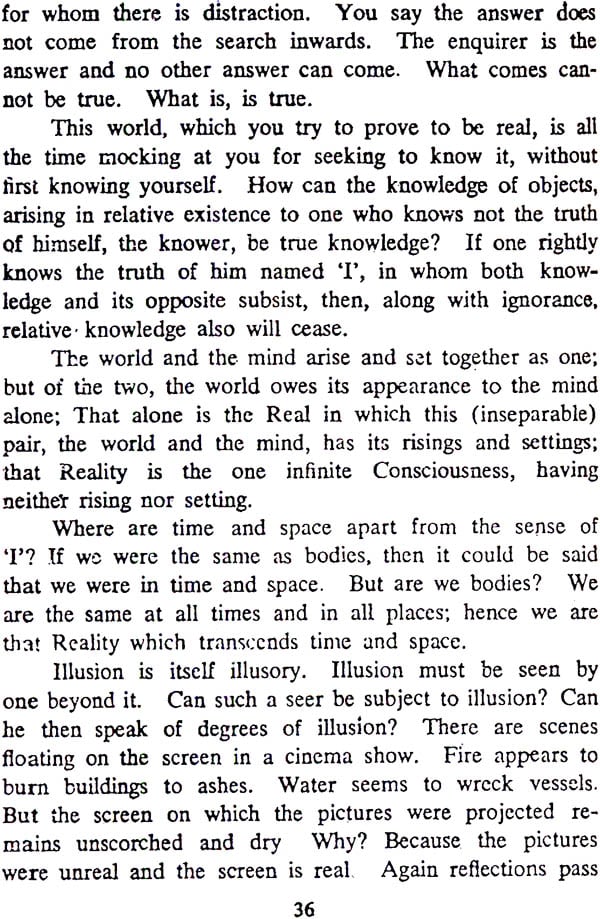
Erase The Ego
Book Specification
| Item Code: | IHL649 |
| Author: | Sri Ramana Maharshi |
| Publisher: | Bharatiya Vidya Bhavan |
| Edition: | 2018 |
| ISBN: | 9788172765149 |
| Pages: | 58 |
| Cover: | Paperback |
| Other Details | 7.2 inch X 4.8 inch |
| Weight | 70 gm |
Book Description
Sri Ramana Maharshi
(1879 to 1950 A.D.)
Venkataramana was a lad in his teens in Madurai in South India. Urged by an inner call, the body played the truant, slipped away from home and soon found himself in the solitary caves of the Arunachala Hills. There he forgot the world, and, insensible to hunger and thirst and reckless of the ravages which crawling creatures wrought on his body, he immersed himself in concentrated meditation.
After a number of years of his phenomenal tapas, incredibly unrelieved by any break whatsoever, he emerged with the realization of the Supreme Reality and of the identity of his Self with it. Liberated by that realization from the chains of finitude, he became a Jivanmukta. Proclaimed a Maharsh from that time, Bhagavan Ramana, as he was reverently adored lived ever after in his ashram at Tiruvannamalai in Sahaja Samadhi, always established in the Spirit and overlooking the things, of the World with a smiling serenity.
A living witness to Advaita anubhava, Sri Ramana spent the remainder of his days conveying counsel through his unparted lips and providing comfort by the beam of his gracious eyes to the countless disciples and devotees who sought refuge at his holy feet from their ills of mind and body. ‘Know thy Self and the world will not torment thee was the central teaching of this modern edition of Vamadeva of yore.
THE Bharatiya Vidya Bhavan—that Institute of Indian Culture in Bombay—needed a Book University, a series of books which, if read, would serve the purpose of providing higher education. Particular emphasis, however, was to be put on such literature as revealed the deeper impulsions of India. As a first step, it was decided to bring out in English 100 books, 50 of which were to be taken in hand almost at once. Each book was to contain from 200 to 250 pages.
It is our intention to publish the books we select, not only in English, but also in the following Indian languages; Hindi, Bengali, Gujarati, Marathi, Tamil, Telugu, Kannada and Malayalam.
This scheme, involving the publication of 900 volumes; requires ample funds and an all—India, organisation. The Bhavan is exerting its utmost to supply them.
The objectives for which the Bhavan stands are the re- integration of the Indian culture in the light of modern know- ledge and to suit our present-day needs and the resuscitation of its fundamental values in their pristine vigour. Let me make our goal more explicit:
We seek the dignity of man, which necessarily implies the creation of social conditions which would allow him freedom to evolve along the lines of his own temperament and capacities; we seek the harmony of individual efforts and social relations, not in any makeshift way, but within the frame—work of the Moral Order; we seek the creative art of life, by the alchemy of which human limitations are progressively trans- muted, so that man may become the instrument of God, and is able to see Him in all and all in Him.
The world, we feel, is too much with us. Nothing would uplift or inspire us so much as the beauty and aspiration which such books can teach.
In this series, therefore, the literature of India, ancient and modem will be published in a form easily accessible to all. Books in other literatures of the world, if they illustrate the principles we stand for, will also be included.
This common pool of literature, it is hoped, will enable the reader, eastern or western, to understand and appreciate currents of world thought, as also the movements of the mind in India, which, though they flow through different linguistic channels, have a common urge and aspiration.
Fittingly, the Book University’s first venture is the Mahabharata, summarised by one of the greatest living Indians, C. Rajagopalachari; the second work is on a section of it, the Gita by H. V. Divatia, an eminent jurist and a student of philosophy. Centuries ago, it was proclaimed of the Mahabharata: "What is not in it is nowhere." After twenty—five centuries, we can use the same words about it. He who knows it not, knows not the heights and depths of the soul; he misses the trials and tragedy and the beauty and grandeur of life The Mahabharata is not a mere epic; it is a romance, telling the tale of heroic men and women and of some who were divine: it is/a whole literature in itself, containing a code of life, a philosophy of social and ethical relations, and speculative thought on human problems that is hard to rival; but, above all, it has for its core the Gita, which is, as the world is beginning to find out, the noblest-of scriptures and the grandest of sagas in which the climax is reached in the wondrous Apocalypse in the Eleventh Canto.
Through such books alone the harmonies underlying true culture, I am convinced, will one day reconcile the disorders of modern life.
I thank all those who have helped to make this new branch of the Bhavan’s activity successful.
Herein are a few salient and solemn Teachings of Bhagavan Sri Ramana Maharshi, the Sage of Tiruvannamalai, South India. These sacred teachings were culled from his talks and works published by Sri Ramanashram, Tiruvannamalai. They are all in his own words.
| Kulapati’s Preface | v | |
| Foreword | ix | |
| Invocatory | 1 | |
| Benedictory | 2 | |
| Prefatory | 3 | |
| Teachings | 9 | |
| Talks | 50 |






